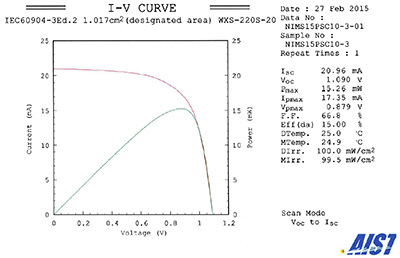First certified efficiency of 15% in Perovskite Solar Cells with area of over 1cm2
2015.05.01
(2015.06.17 Update)
National Institute for Materials Science (NIMS)
The research group at the NIMS Photovoltaic Materials Unit achieved 15% energy conversion efficiency in perovskite solar cells for the first time certified at an international public test center.
Abstract
- A research group led by Dr. Liyuan Han, the leader of the Photovoltaic Materials Unit at the National Institute for Materials Science (NIMS, Sukekatsu Ushioda, president) achieved 15% energy conversion efficiency in perovskite solar cells for the first time in the world as officially recognized by an international public test center.
- The most conversion efficiencies in perovskite solar cells reported thus far had been measured using small-sized cells (about 0.1 cm2). A conversion efficiency of 20.1% has been reported previously, but the measurement error was large in that study due to the small-sized cells used (0.0955 cm2) and the report did not present the measurement method. To steadily advance R&D of perovskite solar cells based on reliable data, it is an important issue to measure the conversion efficiencies at international public test center.
- The research group attained increased conversion efficiency and reproducibility of perovskite solar cells by controlling morphology of perovskite layer with new fabricating method. In addition, since the conventional material used for a charge carrier transport layer is hydrophilic, the conversion efficiency of the cell deteriorates rapidly. Here, we developed a new charge transport material which shows hydrophobicity and high carrier mobility, and successfully improved the stability of perovskite solar cells with this new material. Based on these results, we expanded the solar cell to more than 1 cm square and improved the method to create the device. As a result, we achieved 15% conversion efficiency in perovskite solar cells for the first time in the world certified by the international public test center (Calibration, Standards and Measurement Team at the Research Center for Photovoltaics, National Institute of Advanced Industrial Science and Technology).
- On the basis of these outcomes, we aim to further improve conversion efficiency by developing new carrier transport materials with even higher performance and controlling interfaces in perovskite solar cells.
- This research was in part conducted in conjunction with a JST (Japan Science and Technology Agency) sponsored research project, “Device physics of dye-sensitized solar cells” (research supervisor: Masafumi Yamaguchi, Principal Professor at Toyota Technological Institute), under the research area “Creative research for clean energy generation using solar energy” in the Core Research of Evolutional Science & Technology (CREST) program. This study was presented at the International Conference on Hybrid and Organic Photovoltaics 2015 held in Rome, Italy, from May 10 through 13.

Figure: Current-voltage characteristics in perovskite solar cells measured by the Calibration, Standards and Measurement Team at the AIST Research Center for Photovoltaics.